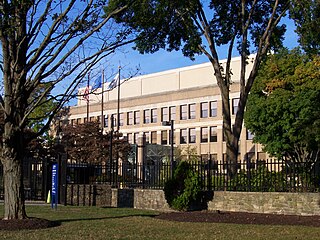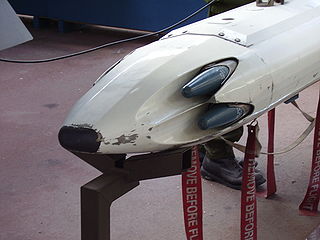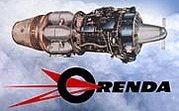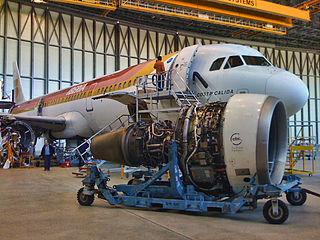
Pratt & Whitney is an American aerospace manufacturer with global service operations. It is a subsidiary of RTX Corporation. Pratt & Whitney's aircraft engines are widely used in both civil aviation and military aviation. Its headquarters are in East Hartford, Connecticut. The company is the world's second largest commercial aircraft engine manufacturer, with a 35% market share as of 2020. In addition to aircraft engines, Pratt & Whitney manufactures gas turbine engines for industrial use, marine propulsion, and power generation. In 2017, the company reported that it supported more than 11,000 customers in 180 countries around the world.

The Bristol Aeroplane Company, originally the British and Colonial Aeroplane Company, was both one of the first and one of the most important British aviation companies, designing and manufacturing both airframes and aircraft engines. Notable aircraft produced by the company include the 'Boxkite', the Bristol Fighter, the Bulldog, the Blenheim, the Beaufighter, and the Britannia, and much of the preliminary work which led to Concorde was carried out by the company. In 1956 its major operations were split into Bristol Aircraft and Bristol Aero Engines. In 1959, Bristol Aircraft merged with several major British aircraft companies to form the British Aircraft Corporation (BAC) and Bristol Aero Engines merged with Armstrong Siddeley to form Bristol Siddeley.

The British Aircraft Corporation (BAC) was a British aircraft manufacturer formed from the government-pressured merger of English Electric Aviation Ltd., Vickers-Armstrongs (Aircraft), the Bristol Aeroplane Company and Hunting Aircraft in 1960. Bristol, English Electric and Vickers became "parents" of BAC with shareholdings of 20%, 40% and 40% respectively. BAC in turn acquired the share capital of their aviation interests and 70% of Hunting Aircraft several months later.

Aerospace is a term used to collectively refer to the atmosphere and outer space. Aerospace activity is very diverse, with a multitude of commercial, industrial, and military applications. Aerospace engineering consists of aeronautics and astronautics. Aerospace organizations research, design, manufacture, operate, or maintain both aircraft and spacecraft.

Piaggio Aerospace, formerly Piaggio Aero Industries, is a multinational aerospace manufacturing company headquartered in Villanova d'Albenga, Italy. The company designs, develops, manufactures and maintains aircraft, aero-engines, aerospace components and aerostructures.

Hindustan Aeronautics Limited (HAL) is an Indian public sector aerospace and defence company, headquartered in Bangalore. Established on 23 December 1940, HAL is one of the oldest and largest aerospace and defence manufacturers in the world. HAL began aircraft manufacturing as early as 1942 with licensed production of Harlow PC-5, Curtiss P-36 Hawk and Vultee A-31 Vengeance for the Indian Air Force. HAL currently has 11 dedicated Research and development (R&D) centres and 21 manufacturing divisions under 4 production units spread across India. HAL is managed by a board of directors appointed by the President of India through the Ministry of Defence, Government of India. HAL is currently involved in designing and manufacturing of fighter jets, helicopters, jet engine and marine gas turbine engine, avionics, software development, spares supply, overhauling and upgrading of Indian military aircraft.

The CRV7, short for "Canadian Rocket Vehicle 7", is a 2.75-inch (70 mm) folding-fin ground attack rocket produced by Bristol Aerospace in Winnipeg, Manitoba. It was introduced in the early 1970s as an upgraded version of the standard U.S. 2.75-inch air-to-ground rockets. It was the most powerful weapon of its class, the first with enough energy to penetrate standard Warsaw Pact aircraft hangars. The CRV7 remains one of the most powerful air-to-ground attack rockets to this day, and has slowly become the de facto standard for Western-aligned forces outside the United States. Beginning in 2021, 83,303 stored Canadian CRV7s are slated for disposal having been removed from service from 2005 to 2007. In 2024 the Department of National Defence considers the rockets it still has to be donated to Ukraine as military aid to defend against the Russian invasion of Ukraine.

Safran Helicopter Engines, previously known as Turbomeca, is a French manufacturer of low- and medium-power gas turbine turboshaft engines for helicopters. The company also produces gas turbine engines for aircraft and missiles, as well as turbines for land, industrial and marine applications.

Volvo Aero was a Swedish aircraft, guided missiles and rocket engine manufacturer. It became GKN Aerospace Engine Systems following the company's acquisition by British engineering conglomerate GKN during 2012.

Filton Airport or Filton Aerodrome was a private airport in Filton and Patchway, within South Gloucestershire, 4 NM north of Bristol, England.

Orenda Engines was a Canadian aircraft engine manufacturer and parts supplier. As part of the earlier Avro Canada conglomerate, which became Hawker Siddeley Canada, they produced a number of military jet engines from the 1950s through the 1970s, and were Canada's primary engine supplier and repair company.

ITP Aero is a Spanish aero engine and gas turbine manufacturer.
Dowty Propellers is a British engineering company based in Brockworth, Gloucestershire that specialises in the manufacture, repair and overhaul of propellers and propeller components for customers around the world. It is owned by General Electric, forming part of its GE Aviation Systems division.
Magellan Aerospace Corporation is a Canadian manufacturer of aerospace systems and components. Magellan also repairs and overhauls, tests, and provides aftermarket support services for engines, and engine structural components. The company's business units are divided into the product areas of aeroengines, aerostructures, rockets and space, and specialty products. Its corporate offices in Mississauga, Ontario, Magellan operates in facilities throughout Canada, the United States, and the United Kingdom.
Boeing Canada is the Canadian subsidiary of Boeing, with operations in Winnipeg, MB, Richmond, BC, Montreal, QC and Ottawa, ON. Boeing employs more than 1,600 people in Canada. Boeing Aircraft of Canada Limited was formed in 1929 by the American Boeing Airplane Company.

The Orenda PS.13 Iroquois was an advanced turbojet engine designed for military use. It was developed by the Canadian aircraft engine manufacturer Orenda Engines, a part of the Avro Canada group. Intended for the CF-105 Arrow interceptor, development was cancelled, along with the Arrow, in 1959.

Aircraft maintenance is the performance of tasks required to ensure the continuing airworthiness of an aircraft or aircraft part, including overhaul, inspection, replacement, defect rectification, and the embodiment of modifications, compliance with airworthiness directives and repair.

The aerospace industry of the United Kingdom is the second-largest national aerospace industry in the world and the largest in Europe by turnover, with a global market share of 17% in 2019. In 2020, the industry employed 116,000 people.
Hants and Sussex Aviation Ltd was a British aviation manufacturer. Based at Portsmouth Airport, Hampshire, England, throughout much of its existence, the company is still in business in the aircraft components industry.


















